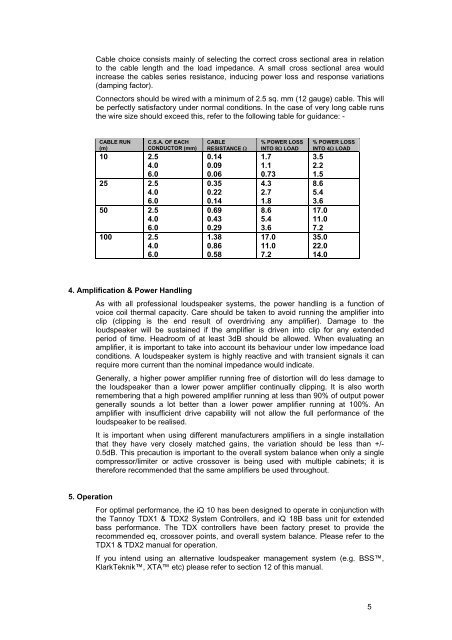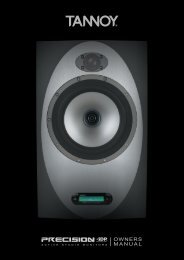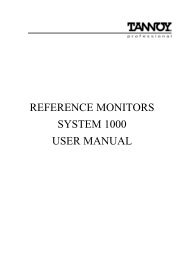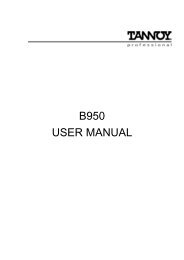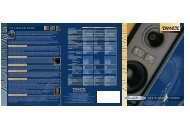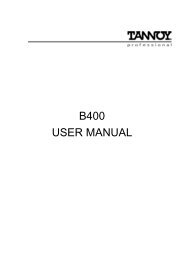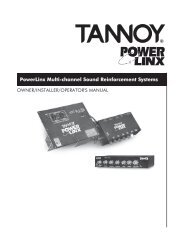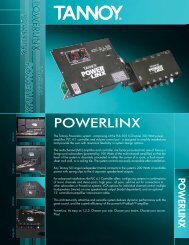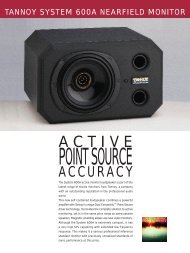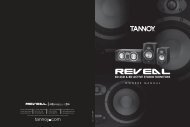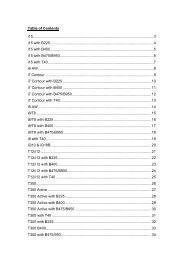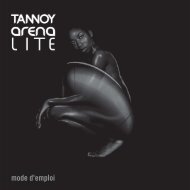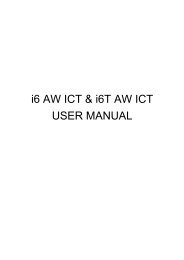iQ SERIES USER MANUAL - Tannoy
iQ SERIES USER MANUAL - Tannoy
iQ SERIES USER MANUAL - Tannoy
Create successful ePaper yourself
Turn your PDF publications into a flip-book with our unique Google optimized e-Paper software.
Cable choice consists mainly of selecting the correct cross sectional area in relation<br />
to the cable length and the load impedance. A small cross sectional area would<br />
increase the cables series resistance, inducing power loss and response variations<br />
(damping factor).<br />
Connectors should be wired with a minimum of 2.5 sq. mm (12 gauge) cable. This will<br />
be perfectly satisfactory under normal conditions. In the case of very long cable runs<br />
the wire size should exceed this, refer to the following table for guidance: -<br />
CABLE RUN<br />
(m)<br />
10 2.5<br />
4.0<br />
6.0<br />
25 2.5<br />
4.0<br />
6.0<br />
50 2.5<br />
4.0<br />
6.0<br />
100 2.5<br />
4.0<br />
6.0<br />
C.S.A. OF EACH<br />
CONDUCTOR (mm)<br />
CABLE<br />
RESISTANCE Ω<br />
0.14<br />
0.09<br />
0.06<br />
0.35<br />
0.22<br />
0.14<br />
0.69<br />
0.43<br />
0.29<br />
1.38<br />
0.86<br />
0.58<br />
% POWER LOSS<br />
INTO 8Ω LOAD<br />
1.7<br />
1.1<br />
0.73<br />
4.3<br />
2.7<br />
1.8<br />
8.6<br />
5.4<br />
3.6<br />
17.0<br />
11.0<br />
7.2<br />
% POWER LOSS<br />
INTO 4Ω LOAD<br />
3.5<br />
2.2<br />
1.5<br />
8.6<br />
5.4<br />
3.6<br />
17.0<br />
11.0<br />
7.2<br />
35.0<br />
22.0<br />
14.0<br />
4. Amplification & Power Handling<br />
As with all professional loudspeaker systems, the power handling is a function of<br />
voice coil thermal capacity. Care should be taken to avoid running the amplifier into<br />
clip (clipping is the end result of overdriving any amplifier). Damage to the<br />
loudspeaker will be sustained if the amplifier is driven into clip for any extended<br />
period of time. Headroom of at least 3dB should be allowed. When evaluating an<br />
amplifier, it is important to take into account its behaviour under low impedance load<br />
conditions. A loudspeaker system is highly reactive and with transient signals it can<br />
require more current than the nominal impedance would indicate.<br />
Generally, a higher power amplifier running free of distortion will do less damage to<br />
the loudspeaker than a lower power amplifier continually clipping. It is also worth<br />
remembering that a high powered amplifier running at less than 90% of output power<br />
generally sounds a lot better than a lower power amplifier running at 100%. An<br />
amplifier with insufficient drive capability will not allow the full performance of the<br />
loudspeaker to be realised.<br />
It is important when using different manufacturers amplifiers in a single installation<br />
that they have very closely matched gains, the variation should be less than +/-<br />
0.5dB. This precaution is important to the overall system balance when only a single<br />
compressor/limiter or active crossover is being used with multiple cabinets; it is<br />
therefore recommended that the same amplifiers be used throughout.<br />
5. Operation<br />
For optimal performance, the <strong>iQ</strong> 10 has been designed to operate in conjunction with<br />
the <strong>Tannoy</strong> TDX1 & TDX2 System Controllers, and <strong>iQ</strong> 18B bass unit for extended<br />
bass performance. The TDX controllers have been factory preset to provide the<br />
recommended eq, crossover points, and overall system balance. Please refer to the<br />
TDX1 & TDX2 manual for operation.<br />
If you intend using an alternative loudspeaker management system (e.g. BSS,<br />
KlarkTeknik, XTA etc) please refer to section 12 of this manual.<br />
5


